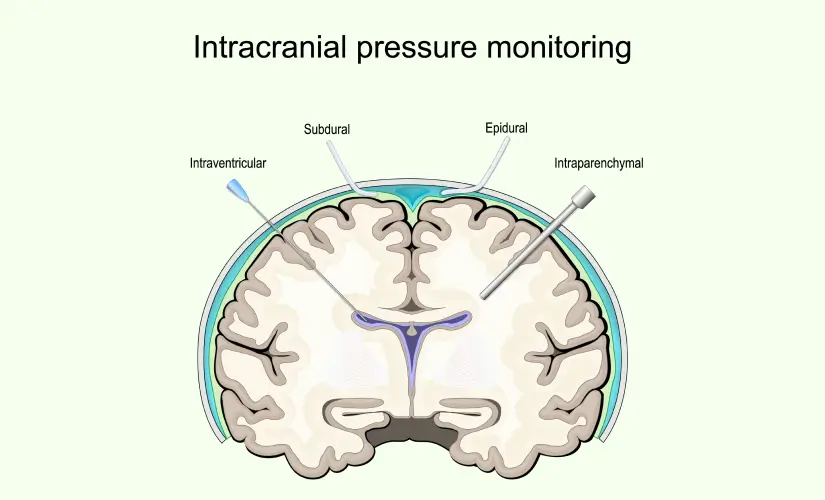-
Doctors
-
Specialities & Treatments
Centre of Excellence
Specialties
Treatments and Procedures
Hospitals & Directions HyderabadCARE Hospitals, Banjara Hills CARE Outpatient Centre, Banjara Hills CARE Hospitals, HITEC City CARE Hospitals, Nampally Gurunanak CARE Hospitals, Musheerabad CARE Hospitals Outpatient Centre, HITEC City CARE Hospitals, Malakpet
HyderabadCARE Hospitals, Banjara Hills CARE Outpatient Centre, Banjara Hills CARE Hospitals, HITEC City CARE Hospitals, Nampally Gurunanak CARE Hospitals, Musheerabad CARE Hospitals Outpatient Centre, HITEC City CARE Hospitals, Malakpet Raipur
Raipur
 Bhubaneswar
Bhubaneswar Visakhapatnam
Visakhapatnam
 Nagpur
Nagpur
 Indore
Indore
 Chh. Sambhajinagar
Chh. SambhajinagarClinics & Medical Centers
Book an AppointmentContact Us
Online Lab Reports
Book an Appointment
Consult Super-Specialist Doctors at CARE Hospitals

Intracranial Pressure
Symptom, Causes, Diagnosis and Treatment
Intracranial Pressure
An increase in intracranial pressure (ICP) can occur when pressure rises within the cranial vault. Normal intracranial pressure stays below 20 millimetres of mercury (mm Hg). According to the Monroe-Kellie Doctrine, the cranium's three components—brain tissue, cerebrospinal fluid (CSF), and blood—exist in volume equilibrium. The overall pressure rises if one component increases in volume without a decrease in the others.

Symptoms of Increased Intracranial Pressure
People with raised intracranial pressure show some distinctive warning symptoms. The following are some raised intracranial pressure signs:
- Headaches (typically worse in the morning or when lying down)
- Nausea and vomiting
- The altered mental status can be in any form, from drowsiness to coma
- Vision changes, including blurred vision, double vision, and light sensitivity
- Muscle weakness and numbness
- Seizures
Causes of Increased Intracranial Pressure
The reasons for intracranial pressure fall into several categories:
- Brain tissue increases: Swelling (cerebral oedema) from trauma, stroke, tumours, or infections
- CSF imbalances: Hydrocephalus, decreased reabsorption, or increased production
- Blood volume changes: Aneurysms, venous thrombosis, or heart failure
Other factors include idiopathic intracranial hypertension, skull deformities, excessive vitamin A, and certain medications like tetracycline.
Risks of Increased Intracranial Pressure
Scientists haven't determined the true incidence, though traumatic brain injury (TBI) remains a major risk factor.
Complications of Increased Intracranial Pressure
Untreated increased intracranial pressure guides to serious complications. Brain injury occurs because cerebral ischemia reduces brain perfusion. On top of that, patients might experience seizures, stroke, permanent neurological damage, and death in severe cases. The greatest danger emerges when high pressure pushes brain tissue downward, causing herniation—a potentially fatal outcome.
Diagnosis
Nervous system assessment: During a nervous system exam, doctors test the patient's senses, balance, and mental status. They also examine the patient's eyes with an ophthalmoscope to spot papilledema, which signals raised pressure.
Several tests confirm the diagnosis:
- Imaging tests: CT scans or MRIs show detailed images of brain swelling, enlarged ventricles, or mass effects
- Lumbar puncture (spinal tap): This measures cerebrospinal fluid pressure directly. Readings above 20 mm Hg point to increased ICP
- ICP monitoring: Devices placed through the skull provide continuous pressure readings
Treatments for Increased Intracranial Pressure
The treatment modality depends on how severe the condition is and what causes it. The simple measures come first. These include raising the bed's head above 30 degrees and keeping the neck straight to improve venous drainage.
Medical treatments often include:
- Medications: Osmotic agents create osmotic gradients that pull fluid from the brain
- CSF drainage: An external ventricular drain removes cerebrospinal fluid to lower pressure
- Sedation and ventilation: This controls breathing and reduces agitation that could raise pressure
Surgical options become necessary in stubborn cases. A decompressive craniectomy removes part of the skull to allow brain swelling and serves as a last-resort treatment.
When to See a Doctor
Head straight to emergency if you experience:
- Severe headaches
- Blurred vision
- Decreased alertness
- Vomiting
- Behaviour changes
- Weakness
- Speech problems
- Extreme sleepiness
- Seizures
Prevention
You can reduce risk factors for increased intracranial pressure in several ways.
- Regular exercise, a healthy weight & a balanced diet lower your chances of high blood pressure and stroke.
- Older adults can benefit from fall prevention programmes that reduce head injury risks.
- Safety gear is essential during contact sports, cycling, or motorcycling.
- Seatbelts protect you against traumatic brain injuries that could cause increased pressure while driving.
FAQs
1. What is the main cause of intracranial pressure?
The most important causes of increased intracranial pressure include:
- Brain swelling (cerebral oedema) from trauma, stroke, or infection
- Bleeding in the brain (intracerebral or subdural hematomas)
- Brain tumours or abscesses
- Hydrocephalus (abnormal buildup of cerebrospinal fluid)
- Meningitis or encephalitis
- High blood pressure that leads to brain haemorrhage
2. What is a normal intracranial pressure reading?
Adults typically show intracranial pressure between 7 to 15 millimetres of mercury (mm Hg). Doctors usually accept readings below 20 mm Hg.
Doctors start treatments to lower ICP when pressure goes above 20 to 25 mm Hg.
3. What deficiency causes head pressure?
Head pressure is related to several nutritional deficiencies. Magnesium deficiency is the most important factor, and most people show clinical or subclinical deficiency. Blood work often reveals magnesium deficiencies in people who suffer from migraines.
Low levels of these nutrients also matter:
- Riboflavin (Vitamin B2) - plays an elementary role in preventing headaches
- Vitamin D - a common deficiency tied to headache symptoms
- Essential fatty acids (Omega-3, Omega-6) - their lack might cause head pressure
4. Can anxiety cause head pressure?
Anxiety often creates feelings of pressure or tension in your head. Your body releases stress hormones like cortisol & adrenaline during anxiety, which tightens muscles around your neck, shoulders, and head. This muscle tension creates various types of head pain, including tension headaches and pressure sensations. This creates a cycle - anxiety brings head pressure, which makes anxiety worse, and the original symptoms can intensify.
Still Have a Question?


